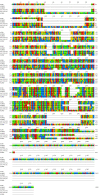The PCNA pseudogenes in the human genome
- PMID: 22309575
- PMCID: PMC3296674
- DOI: 10.1186/1756-0500-5-87
The PCNA pseudogenes in the human genome
Abstract
Background: The proliferating cell nuclear antigen (PCNA) is a key protein in the eukaryotic DNA replication and cell proliferation. Following the cloning and characterisation of the human PCNA gene, the question of the existence of pseudogenes in the human genome was raised.
Findings: In this short communication we summarise the existing information about the PCNA pseudogenes and critically assess their status.
Conclusions: We propose the existence of at least four valid PCNA pseudogenes, PCNAP1, PCNAP2, LOC392454 and LOC390102. We would like to recommend assignment of a name for LOC392454 as "proliferating cell nuclear antigen pseudogene 3" (alias PCNAP3) and a name for LOC390102 as "proliferating cell nuclear antigen pseudogene 4" (alias PCNAP4). We prompt for more critical evaluation of the existence of a PCNA pseudogene, designated as PCNAP.
Figures



References
-
- Miyachi K, Fritzler MJ, Tan EM. Autoantibody to a nuclear antigen in proliferating cells. J Immunol. 1978;121:2228–2234. - PubMed
-
- Tan CK, Castillo C, So AG, Downey KM. An auxiliary protein for DNA polymerase-delta from fetal calf thymus. J Biol Chem. 1986;261:12310–12316. - PubMed
-
- Travali S, Ku DH, Rizzo MG, Ottavio L, Baserga R, Calabretta B. Structure of the human gene for the proliferating cell nuclear antigen. J Biol Chem. 1989;264:7466–7472. - PubMed
LinkOut - more resources
Full Text Sources
Miscellaneous

